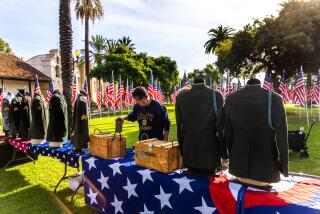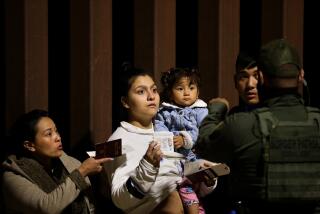Californians Had Right Stuff for Airlift : Europe: Former pilots recall how they helped supply 1.5 million Germans during the 1948-49 Soviet blockade.
- Share via
BERLIN — Kenneth Herman, a retired Air Force pilot living in San Bernardino, has his own striking memories of America’s postwar activities in Berlin. One snowy day in January, 1949, at the height of the Berlin airlift, as he was easing his C-54 transport down onto the city’s rough airfield he felt the whole plane start to shake.
Herman says he started praying, brought the nose down, and felt the landing gear collapse beneath him. He did what he could to get the crippled plane off the runway--another transport was due in three minutes--and then, without missing a beat, climbed down, found an empty aircraft and boarded it for another flight to northern Germany, another load of coal for the stricken population of Berlin.
“We knew what we were doing,” said Herman, who arrived here from California this week for ceremonies commemorating the 1948-49 Berlin airlift, an official guest of a still-grateful German government. “We just wanted to get going, to move more stuff into Berlin. You see, when you’re young, you think you’re invincible.”
Today Herman is 72 years old, and president of the Berlin Airlift Veterans Assn., a nonprofit group dedicated to educating people about the Cold War’s first great battle, fought here 46 years ago. He and nine other members of the association--including five from Southern California--traveled to Berlin with several widows of the 31 Americans who were killed during the operation.
As a group, the 10 airlift veterans flew more than 1,500 flights into this city, bombed-out as it still was a few years after World War II, and nearly frozen and starving under a Soviet blockade. Herman himself flew 190 planeloads of coal into Berlin, and his memories are of both the danger and difficulty of his mission, and of the joy and pride he felt at having helped to feed 1.5 million people, and making Soviet leader Josef Stalin blink.
“We saved the people of Berlin,” he said. “I think this really started the downfall of communism.”
The airlift didn’t come without hazards, Herman recalled over coffee in the lobby of the Allied Museum Berlin, a newly opened repository of Cold War memorabilia on Berlin’s south side.
*
“About six months (of the flying) was all you could stand,” he said. “It was a strenuous type of flying, so much precision. And always in the back of our minds was the thought of what the Russians might do. They sent fighters up and flew in formation with us. Or sometimes they shone their searchlights and tried to blind us.”
Herman says he often could see the Russian fighters flying nearby, and would feel like a sitting duck in his big, lumbering transport.
“They could have shot down six, eight, 10 airplanes in a matter of minutes,” he said. “Of course, World War III would have started right then. The Russians knew that.”
The Berlin airlift had its high moments, as well--such as when American officers’ wives crafted thousands of little candy-bar parachutes and gave them to the flight mechanics to toss out of the planes as they landed.
*
On May 12, 1949, the Soviets lifted their roadblocks, realizing that the Americans and British were willing and able to supply Berlin indefinitely. The airlift continued until September, 1949, however, with the goods stockpiled on the ground, because the Western Allies didn’t trust Stalin not to block the overland routes again.
Herman returned to California, and to his job as an Air Force test pilot, in February, 1949. He retired from the Air Force in 1966 and went to work for McDonnell Douglas Corp., where he eventually became deputy director of the Titan missile program.
His veterans group was formed in 1990. “You can go anywhere in the United States and you ask the younger people, ‘Do you know anything about the Berlin airlift?’ and they’ll say, ‘No,’ ” he says regretfully. “But we Berlin airlift pilots are proud that we were the pioneers in the first real, sustained humanitarian airlift. We developed techniques that are used today in Somalia, Bosnia and Rwanda.”
Other Southern California airlift veterans participating in this week’s ceremonies in Berlin were Vaun Liniger of Riverside, George Domonouski of San Bernardino, Quentin Raaz of Grand Terrace and Stanley Forester of Fountain Valley.
More to Read
Sign up for Essential California
The most important California stories and recommendations in your inbox every morning.
You may occasionally receive promotional content from the Los Angeles Times.













